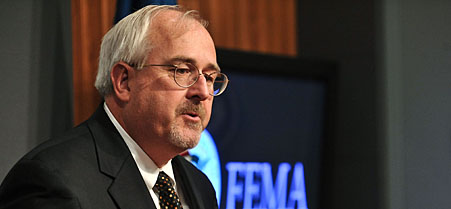FEMA will use social media through all stages of a disaster
Administrator Craig Fugate says agency tracks events through hash tags to plan its response and keep the public informed.
 Nicholas Kamm/Newscom
Nicholas Kamm/Newscom
The Federal Emergency Management Agency is set up to use Twitter at all stages of a disaster, before the event strikes, during the event and after, Administrator Craig Fugate tells Nextgov .
The agency maintains a Twitter page with just under 30,000 followers, and the administrator himself has a personal page, CraigatFEMA , with almost 6,600 followers.
Before a forecast storm hits, today's FEMA can monitor local weather reports and Tweets to advise the public in the affected area. On Tuesday, for example, the agency issued a message about a winter storm likely to hit Oklahoma, New Mexico and North Texas through Wednesday. The agency instructed its followers to be sure to follow the affected state's emergency management offices: "Another #winterstorm for OK, north TX & New Mexico tonight/tmrw. Prepare at http://go.usa.gov/akw & follow @okem @txdps @NMDHSEM."
Fugate said his agency is careful to rely only on official information, such as forecasts from the National Weather Service and links from official emergency management agencies. "It's really important I don't try to pose as a weather service," he said.
The agency also uses social media to anticipate what a state might need to prepare for a predicted disaster. For example, as Hurricane Earl moved up the East Coast in September 2010, Fugate could see by monitoring Twitter that tourists on North Carolina's Outer Banks were evacuating, but many long-term residents were adamant about staying put. That gave the agency a heads-up that there would be people left on the barrier islands, and search and rescue plans were readied.
During an event, FEMA looks for what people are saying on Twitter by tracking the service's hash tags, which an eventual consensus of users assigns to mark a given event. During the major snow and ice storm that moved across the United States in early February, the most commonly used hash tag was #snomg.
During that storm FEMA was able to monitor what was happening on the ground by using HootSuite, a Twitter-adaptable program that displays all Tweets using the given hash tag. Hence FEMA could tell that Oklahoma was getting hit by ice and Chicago residents thought the storm had missed them, until they started Tweeting that it quickly got worse, Fugate said.
Another example he cites occurred with Tropical Cyclone Wilma, which hit American Samoa at the end of January. A unnamed man Tweeted Fugate and started giving him local conditions, using #wilma as a hash tag. "When the storm came ashore, he starts describing things that were happening," Fugate said. "But about midway, when [the storm] reach[ed] peak conditions, he starts Tweeting [NFL] scores." That assured Fugate that critical systems such as electricity were working.
After an event, FEMA will typically re-Tweet information from other government agencies and, using a tool developed by the General Services Administration that shortens .gov Web addresses, the agency can track how many hits each link draws. After the snowstorm, FEMA linked back to the Centers for Disease Control and Prevention: "Very useful in case your power goes out & you have a generator - carbon monoxide safety tips f/ @CDCgov http://go.usa.gov/YEa #snomg." That link was accessed 1,400 times, Fugate said.
There is much re-Tweeting of what FEMA and Fugate post, he said, and that gets the message out there.
NEXT STORY: General Dynamics Pursues Defense Heath IT


